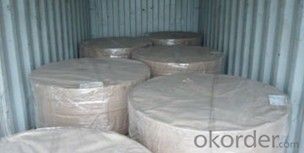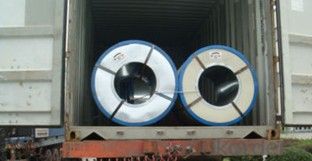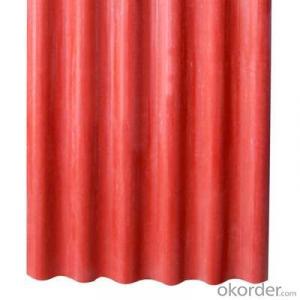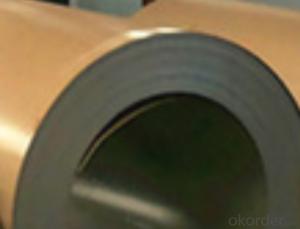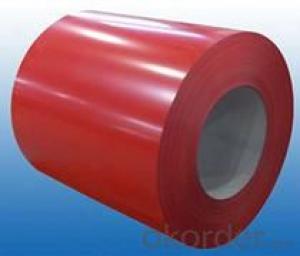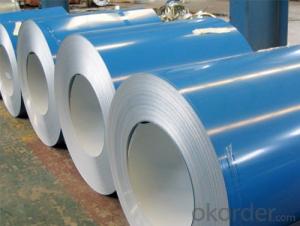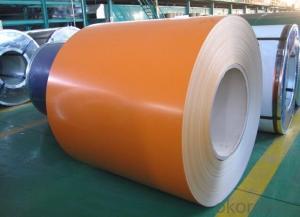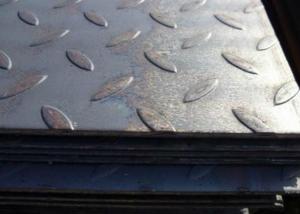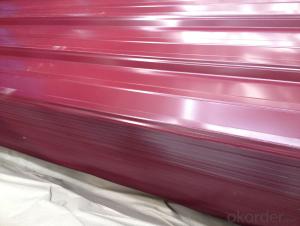Prepainted Galvanized Steel Coil With Best Quality
- Loading Port:
- Tianjin
- Payment Terms:
- TT OR LC
- Min Order Qty:
- 25 m.t.
- Supply Capability:
- 20000 m.t./month
OKorder Service Pledge
OKorder Financial Service
You Might Also Like
Product Name | Prepainted Galvanized Steel Coil With Best Quality |
Brand | CNBM |
Material | DX51D,CGCC,CGCH,CGLCC |
Thickness | 0.14mm-0.8mm |
Width | 750mm-1250mm |
Temper | Full hard,half hard,soft |
Inner Diameter of Coil | 508mm/610mm |
Coating | AZ30-AZ150,Z40-Z275g/m² |
Coil Weight | 2-5mt |
Paint(Top side) | 15-25micron |
Paint(Back side) | 5-10micron |
Color | Ral Chart,as per customer's color swatch |
Paints | PE; HDP; SMP; PVDF |
Application | Structural use ,roofing, commercial use,household appliance,industry etc. |
Package: | Waterproof paper+plastic film+iron packing+bundling,or as per customers request. |
Price terms | FOB,CFR,CIF or as your request |
Delivery time | Within 15-20 days after receipt 30% deposit or L/C at sight |
MOQ | 25 Mt (one 20ft FCL) |
3) Technical Specifications of PPGI steel coil>>>
Test Item | Standard | Result |
T Bend | NCCA11-19 | <3T |
Cupule Test | GB/T9753 | >8mm |
Impact(Shock Force J) | GB/T1732 | >9J |
Adhension(MEK) | GB/T9286 | ≥ 0 |
Pencil Hardness | GB/T6739 | >2H |
Gloss | GB/T1743 | <5% |
Chromatism(E) | ECCA T3 | E<5 |
MEK Scrub Resistance | MCCA11-18 | >100 |
Salt Spray Resistance | GB/T10125 | 500hr |
4) PPGI Prepainted Steel Coil Characteristic >>>
1.Pollution-free and economy
2.Extensive usability
3.Improvement of corporate image
4.Excellent workability, weatherability and elegant appearance.
1) PPGI Prepainted Steel Coil Introduction>>>
Color coated steel is a new prepainted steel product that develops rapidly in the last three decades,which are produced by coating a layer of paint on the surface of cold rolled,galvanized or galvalume coils.The products are made in the process of chemical pretreatment ,initial coating and refining coating by high-speed continuously manufacturing equipment. The coating quality is more smoother,mare stable and more ideal than th quality of brushing.
Color coated can keep the vivid color for a long time with excellent decoration,formability, corrosion resistance and coating adhesion.Color coated steel has become ideal construction material because of its efficient construction, energy conservation and depollution
· Standard: AISI, ASTM, BS, DIN, GB, JIS
· Grade: DX51D,CGCC,CGCH, CGLCC
· Thickness: 0.14mm-0.8mm
· Place of Origin: Shandong, China (Mainland)
· Brand Name: JNC
· Model Number: 0.14mm-0.8mm/750mm-1250mm
· Type: Steel Coil
· Technique: Cold Rolled
· Surface Treatment: Coated
· Application: Structural use ,roofing, commercial use,household appliance,industry
· Special Use: High-strength Steel Plate
· Width: 750mm-1250mm
· Length: Customized or as your request
· Zinc Coating: 40-275g/square meter
· Color: as RAL or as your request
· Trustworthy supplier: Prepainted Steel Coil/sheet
· Coil Weight: 2-5MT
· Paints: Standard Polyester(PE)
· Approved Certificate: ISO9001
· Quality: Top quality
· Test: Will test the products by the Third Part
· Temper: Full hard, half hard,soft
- Q: What is the average thickness of steel sheets?
- The thickness of steel sheets can differ based on multiple factors such as the specific steel type, intended use, and industry norms. Generally, steel sheets can have a thickness ranging from approximately 0.4 millimeters (0.016 inches) to several millimeters (0.1 inches or more). It is crucial to acknowledge that different industries and applications may have specific criteria for steel sheet thickness. Hence, it is advisable to refer to relevant standards or specifications for precise details.
- Q: What are the different jointing methods for steel sheets?
- Steel sheets can be joined using various methods, depending on specific requirements and applications. Common jointing methods for steel sheets include welding, bolting, riveting, adhesive bonding, and mechanical fasteners. Welding is widely used, involving melting the steel sheet edges and joining them by applying heat and pressure. Different welding techniques, like arc welding, gas welding, or laser welding, can be used depending on the steel sheet thickness and type. Bolting involves using bolts and nuts to join steel sheets together. This method is suitable for easily disassembling or replacing joints and can be used for both permanent and temporary connections. Riveting is another method, using rivets to join steel sheets. Rivets are cylindrical metal pins inserted through holes in the sheets and deformed to secure the joint. Riveting is ideal for applications requiring high shear strength. Adhesive bonding uses specialized adhesives to join steel sheets. This method provides a strong and durable joint, suitable when welding or other mechanical jointing methods are not suitable. Adhesive bonding also distributes stress more uniformly across the joint. Mechanical fasteners, like clips, clamps, or brackets, can be used to join steel sheets. These fasteners offer a secure and reliable connection without requiring welding or other permanent jointing methods. They are commonly used when ease of assembly and disassembly is necessary. In conclusion, the choice of jointing method for steel sheets depends on factors such as the application, desired strength and durability, and ease of assembly and disassembly. Careful consideration of these factors is essential to ensure a successful and reliable connection.
- Q: What is the maximum thickness of steel sheets?
- The maximum thickness of steel sheets can vary depending on various factors such as the type of steel being used, the manufacturing process, and the intended application. Generally, steel sheets can range from a few millimeters to several centimeters in thickness. However, for most common applications, the maximum thickness of steel sheets typically falls within the range of 20-30 millimeters. It is essential to consider the specific requirements and specifications of the project or application to determine the appropriate thickness of steel sheets needed.
- Q: How do steel sheets perform in terms of scratch resistance?
- Renowned for their exceptional ability to resist scratches, steel sheets are widely recognized for their strong and durable nature. This quality makes them highly suitable for a multitude of applications where they may come into contact with objects or surfaces that could potentially cause damage. Moreover, steel sheets possess the capacity to endure regular wear and tear, rendering them particularly suitable for demanding environments with heavy usage. Furthermore, the scratch resistance of steel sheets can be further enhanced by applying coatings or finishes, thereby achieving an even higher level of protection. In summary, the outstanding scratch resistance of steel sheets has earned them a well-deserved reputation as a reliable choice for a diverse range of industrial and commercial purposes.
- Q: What is the process of applying anti-corrosion treatments to steel sheets?
- The process of applying anti-corrosion treatments to steel sheets typically involves several steps. Firstly, the steel sheets are thoroughly cleaned and prepared by removing any dirt, grease, or existing rust. This can be done through methods such as sandblasting, chemical cleaning, or mechanical abrasion. Once the sheets are clean, a primer or coating is applied to enhance the corrosion resistance of the steel. This primer acts as a barrier between the steel and the corrosive elements in the environment. The type of primer used depends on the specific requirements and conditions of the application. After the primer has dried, a topcoat or finish is applied to provide additional protection and aesthetic appeal. This topcoat can be a paint, epoxy, powder coating, or other suitable material. The topcoat serves as a final layer of defense against corrosion, UV radiation, and other external factors. The application of these anti-corrosion treatments can be done through various methods such as spraying, dipping, or roller coating. It is important to ensure proper adhesion and coverage of the treatments on all surfaces of the steel sheets. Overall, the process of applying anti-corrosion treatments to steel sheets involves thorough cleaning, priming, topcoating, and ensuring proper application techniques to enhance the durability and longevity of the steel against corrosion.
- Q: Can steel sheets be used for manufacturing industrial shelving?
- Indeed, industrial shelving can be manufactured using steel sheets. Renowned for their robustness and endurance, steel sheets prove to be a perfect choice for demanding tasks like heavy-duty industrial shelving. Able to endure substantial weights, they supply steadfastness and reinforcement to these storage units. Moreover, steel sheets can be effortlessly fashioned and tailored to meet precise dimensions and specifications. Their exceptional resistance to corrosion is of utmost significance in industrial settings where encounters with dampness, chemicals, and other harsh circumstances are frequent. All in all, steel sheets present a dependable and enduring option for the production of industrial shelving.
- Q: What is the aging property of steel plates?
- Timeliness refers to the change in performance with time.
- Q: What is the typical thickness tolerance for steel sheets?
- The typical thickness tolerance for steel sheets can vary depending on the specific industry and application requirements. However, in general, the standard thickness tolerance for steel sheets is typically around ±0.005 to ±0.010 inches (0.13 to 0.25 mm). This means that the actual thickness of the steel sheet can deviate within this range from the specified nominal thickness. It is important to note that certain industries or applications may have more stringent tolerance requirements, especially when precision is critical. In such cases, the tolerance may be tighter, ranging from ±0.001 to ±0.003 inches (0.025 to 0.076 mm). Additionally, specialized steel products or specific customer requirements may also result in different tolerance specifications. To ensure compliance with the desired thickness tolerance, manufacturers employ strict quality control measures such as precise calibration of equipment, regular inspection of raw materials, and comprehensive testing procedures. This helps to maintain the integrity and reliability of steel sheets for various applications in industries such as automotive, construction, manufacturing, and more.
- Q: What is the difference between stainless steel and regular steel sheets?
- The main difference between stainless steel sheets and regular steel sheets lies in their composition and properties. Stainless steel is an alloy that contains a high percentage of chromium, which provides excellent corrosion resistance. It also typically includes nickel and other elements, making it highly resistant to stains, rust, and oxidation. Regular steel sheets, on the other hand, do not have these additional elements and are more prone to rust and corrosion. Stainless steel sheets are commonly used in industries where corrosion resistance is crucial, such as in the manufacturing of kitchen appliances, automobiles, and medical equipment. Regular steel sheets, however, are often used in construction and general manufacturing applications.
- Q: What are the different sheet metal finishing techniques for steel sheets?
- Some of the different sheet metal finishing techniques for steel sheets include deburring, grinding, polishing, sanding, and painting.
Send your message to us
Prepainted Galvanized Steel Coil With Best Quality
- Loading Port:
- Tianjin
- Payment Terms:
- TT OR LC
- Min Order Qty:
- 25 m.t.
- Supply Capability:
- 20000 m.t./month
OKorder Service Pledge
OKorder Financial Service
Similar products
Hot products
Hot Searches
Related keywords



